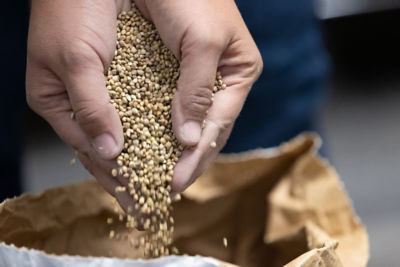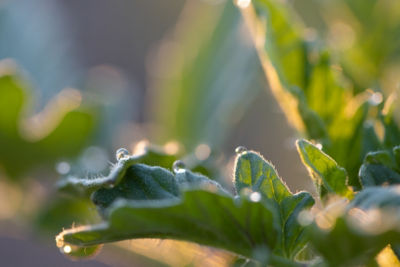Click here to download a PDF version of this spotlight.
» Cabbage maggot larvae damage roots of cruciferous crops reducing yield potential.
» Plants are most susceptible to damage in the seedling state and during cool, wet conditions.
» Cultural practices, insecticide applications, and the presence of natural enemies can be used to manage cabbage maggot.
The cabbage maggot (Delia radicum) is a pest of cruciferous crops, including broccoli, cabbage, canola, cauliflower, radishes, rutabaga, and turnip. The adult stage of the cabbage maggot is a fly that looks similar to a common housefly but is about half the size (¼ inch long). The adults are an ash-gray color with dark stripes along the back of their abdomen (Figure 1). The adult female lays small (⅛ inch), white, bullet-shaped eggs in the soil near the stems of Brassica plants. The maggots (larvae) are small (⅓ inch), white, and legless.1,2,3
 Figure 1. Root-maggot flies, Delia spp. Whitney Cranshaw, Colorado State University, Bugwood.org.
Figure 1. Root-maggot flies, Delia spp. Whitney Cranshaw, Colorado State University, Bugwood.org.
DAMAGE
Damage from cabbage maggots result from the larvae feeding on the roots of cruciferous crops (Figure 2). Cabbage maggot activity is favored by cool, wet weather. As a result, early season, spring-planted crops are most susceptible.2,4 Seedlings are most susceptible during the first month after thinning or transplanting. Feeding can rapidly kill young, direct-seeded plants, while affected transplants usually die more slowly.5
 Figure 2. Cabbage maggot infested root systems showing considerable damage compared to uninfested roots. Photo courtesy of Shimat V. Joseph, University of Georgia.
Figure 2. Cabbage maggot infested root systems showing considerable damage compared to uninfested roots. Photo courtesy of Shimat V. Joseph, University of Georgia.
When they feed, larvae often create channels and tunnels in the roots. These wounds can provide openings for infection by pathogens that cause diseases such as blackleg and bacterial soft rot. 3 The initial symptoms of cabbage maggot infestation include stunting, plants developing a yellow, pale-green, or purple color, and wilting of plants during the heat of the day. Plants may later collapse, wilt, and die.1,3
LIFE CYCLE
The cabbage maggots overwinter as pupae in the soil near the roots of cruciferous plants. Adult flies emerge from the soilborne pupae, and they can fly at least a mile to find suitable hosts.1,2,4 Within one week of emergence, the adult females lay eggs in the soil near the stems of brassica plants. They continue to lay eggs for five to six weeks. The eggs survive best in cool, moist soil. Soil temperatures above 95°F in the top two to three inches will kill the eggs.1,2
The larvae hatch in three to ten days and move down through the soil to feed on small roots and root hairs then tunnel into the taproot. After three to four weeks, the larvae will pupate in the soil or within the root.2 In the summer and early fall, the pupation stage will last for about two weeks, after which the next generation of adult flies will emerge. At the end of the season, the pupa will remain in the soil, overwinter, and serve as the source of infestation the following spring.1
There can be one to several generations per season depending on the length of the season. In Alberta, Canada, there are one or two generations per year. There are typically two to three generations per year in Wisconsin and three to four generations per year in Massachusetts.1,2,4
MONITORING
Pupae will not develop into adult flies at temperatures below 43°F. Therefore, the emergence of adults can be predicted using 40°F (or 43°F) base-temperature degree-day (DD) models.1,4 Approximately 75% of adults will emerge by the time 300 DD have accumulated, and the peak flight of the first-generation adults will occur at about 452 DD. Secondgeneration adults will emerge after an accumulation of 1476 DD, and a third-generation will emerge after 2652 DD.1,4
Adult populations can also be monitored in the spring using yellow sticky cards or sweep nets. Cards should be placed in or slightly above the crop canopy and checked every three to five days.1,2,4 Later in the season, monitoring is done by evaluating roots for the presence of larvae. Look for plants that are wilted, stunted, or off-color. Carefully pull a few plants and look for taproot feeding (tunnels and channels). Examine several Seedlings can be checked for cabbage maggot eggs before transplanting or after they are in the field. The small, white eggs will be located along the stems near the soil line. Check twenty five plants in groups of two to five plants from random locations. An average of one egg per stem is an indication that crop damage may be likely if not treated.1
MANAGEMENT
Rotate to non-cruciferous crops to reduce the number of overwintering pupae in the soil. Control cruciferous weeds, including shepherd’s purse, wild mustard, water cress, and wild radish during the rotation.1,2,4 Start seedlings in fumigated or steamed soil, and avoid raising seedlings near infested fields.3
Cultivate fields before seeding to bring pupae up to the soil surface where they are more susceptible to natural enemies. Till-in cover crops at least two to three weeks before planting, as decaying cover crop debris can attract adult flies. For the same reason, avoid planting in fields where animal manure has been recently applied.2,4 Time seeding or transplanting to avoid exposing seedlings to the peak flights of cabbage maggot adults. It is best to plant after soil temperatures exceed 50°F or after the first-generation adults have emerged, once 300 DD base-T 40°F have accumulated. However, transplanting seedlings one to two weeks before the anticipated peak of adult emergence can help lower the impact of cabbage maggots on non-root crops. Crops planted after mid-June are usually less affected by cabbage maggot than are early planted crops.4,5 Adult flies are attracted to moisture in the seed-rows. So, when direct seeding, dragging a chain behind the planter to smooth out the rows can reduce this source of attraction.3
Covering young seedlings with floating row covers as soon as plants are set can prevent adults from laying eggs near the seedlings. The edges of the row covers should be sealed to prevent flies enering under the cover. Row covers may need to be removed and then replaced to allow for weeding operations. Remove row covers after the first flight of cabbage maggot flies. Do not use row covers in fields that contained brassica crops in the previous year, as adults emerging from pupae in the soil will be trapped under the cover.1,4
Promote vigorous growth so that plants can better tolerate larval root feeding. Destroy (incorporate) crop residues promptly after harvest to reduce the number of overwintering pupae in the soil. Tillage in the fall can also bring pupae to the soil surface, exposing them to natural enemies and adverse environmental conditions.1,2,4
Insecticides can be used to manage cabbage maggots on brassica crops. It is recommended that an insecticide should be applied two to three days after the action threshold of one egg per stem is reached when scouting seedlings.1 If the examination of roots of older plants show feeding damage (root tunnels) but no larvae are present, then an insecticide treatment is not necessary as the larvae have pupated.3 Insecticides are most effective when applied directly to the roots when adults, eggs, or larvae are present. A narrow band application over the row using enough water to move the insecticide into the root zone or directing sprays at the base of transplants is recommended for established plantings.1,3,4 If adult flies are predicted to be present, then insecticides can be applied to seed, to transplant furrows, or in transplant water at the time of planting. However, insecticides are often only effective for four to five days, so applications should be timed to coincide with periods when adults are actively laying eggs.1,5 Insecticide applications are not necessary once soil temperatures rise above 95°F. Insecticide active ingredients that are recommended in regional production guides include bifenthrin, chloropyrifos, chlorotraniliprole, cyantranilprole, diazinon, spinosad, and spinetoram.1,5,6
Biological pesticides and natural enemies can also help manage cabbage maggots. Soil-dwelling beetles feed on eggs and pupae, and some beetle species will feed on larvae. These insects are often susceptible to soil-applied insecticides. So, the benefits of insecticide applications should be weighed against the benefits obtained from the the presence of these natural enemies. Parasitic wasps, predatory mites, and fungal insect pathogens can also help keep cabbage maggot populations in check.1 The nematode Steinernema feltiae has been shown to be effective in managing cabbage maggot by colonizing the larvae. The nematodes can be applied to transplants before planting, in the transplant water during planting, or as a soil drench after planting. A post-planting application can be made if adult flights start more than a week after transplanting.1
SOURCES
1 Hazzard, R. 2021. Cabbage root maggot. UMass Amherst, Center for Agriculture, Food, and the Environment.
2 Alberta AFRD. 1996. Cabbage maggot. Agri-Facts, Agdex 622-23. Alberta Agriculture, Food and Rural Development.
3 Natwick, E. 2009. Cabbage maggot. UC Pest Management Guidelines. http://ipm.ucanr.edu/PMG/r108300111.html.
4 Lowenstein, D. and Groves, R. 2019. Cabbage maggot. University of Wisconsin Madison, Entomology. X-number:XHT1030.
5 Colquhoun, J., Groves, R., Nice, G., Chapman, S., Heider, D., Ruark, M., Gevens, A., Jensen, B., and Wang, Y. 2021. Commercial Vegetable Production in Wisconsin 2021.
6 Reiners, S., Bihn, E., Curtis, P., Helms, M., McGrath, M., Nault, B., Seaman, A., and Sosnoskie, L. 2021 Cornell Integrated Crop and Pest Management Guidelines for Commercial Vegetable Production. Cornell Cooperative Extension.
Websites verified 11-18-2021
ADDITIONAL INFORMATION
For additioinal agronomic information please contact your local seed representative.
Performance may vary from location to location and from year to year, as local growing, soil and weather conditions may vary. Growers should evaluate data from multiple locations and years whenever possible and should consider the impacts of these conditions on the grower’s fields. The recommendations in this article are based upon information obtained from the cited sources and should be used as a quick reference for information about broccoli production. The content of this article should not be substituted for the professional opinion of a producer, grower, agronomist, pathologist and similar professional dealing with this specific crop.
BAYER GROUP DOES NOT WARRANT THE ACCURACY OF ANY INFORMATION OR TECHNICAL ADVICE PROVIDED HEREIN AND DISCLAIMS ALL LIABILITY FOR ANY CLAIM INVOLVING SUCH INFORMATION OR ADVICE.
9053_SE_S5 Published 01-05-2022
ALWAYS READ AND FOLLOW PESTICIDE LABEL DIRECTIONS. Not all products are registered in all states and may be subject to use restrictions. The distribution, sale, or use of an unregistered pesticide is a violation of federal and/or state law and is strictly prohibited. Check with your local dealer or representative for the product registration status in your state. Bayer, Bayer Cross Design, and Seminis® are registered trademarks of Bayer Group. All other trademarks are property of their respective owners. For additional product information call toll-free 1-866-99-BAYER (1-866-992-2937) or visit our website at www.BayerCropScience.us. Bayer CropScience LP, 800 North Lindbergh Boulevard, St. Louis, MO 63167. ©2022 Bayer Group. All rights reserved.




